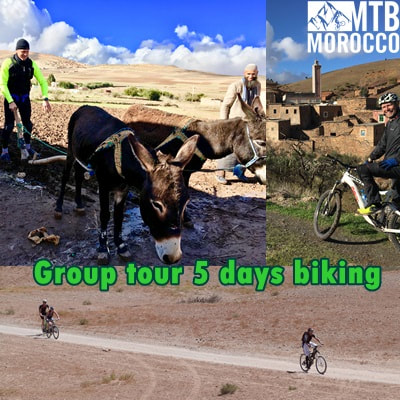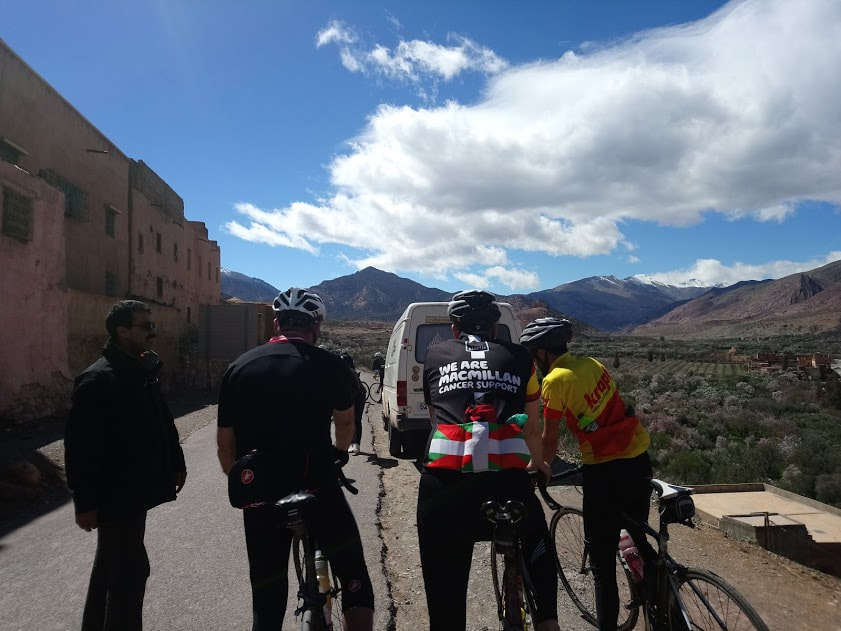Choose how many days you want to do:
Biking or Cycling
MTB MOROCCO
We offer the best MTB tours & cycling road in Morocco, offer a variety of Day excursions and the multi-day trip from Marrakech, Biking and cycling in Morocco, we will work hard to helping you to explore the Berber culture, discovering the High Atlas Berber villages and valleys & the Sahara desert.
Biking ToursMountain bike in Morocco is a "must do", an original MTB experience mountain biking the Atlas Mountains remote valleys and villages, Discover the Berber culture.
|
Cycling ToursFollowing a successful short cycling tour in Morocco, this trip report is for people thinking about such a ride. There a lot of mixed reports about cycling in Morocco
|
Hike And BikeOne from the best activities in the High Atlas Mountain included the red city of Marrakech, cycling,hiking and visit the Historical monuments in Marrakech
|
Our professional guide for the group tours:
|
BRAHIM I’m 27 years old. I’m from the moutain of hight Atlas(exactly from imlil). I’m mountain guide and also cyclist. I’ve got my degree in studies of economics. Questions / Answers: Favourite road cycling climb in the area ? Tizi n’Tasst Favourite place to stop for coffee ? Tahnaout, asni, Ouirgane Favourite local food ? There are many places, especialy marrakech How long has he been guiding and cycling ? I’ve been guide for 6 years, and cycling for 3 years. What makes Marrakesh the best destination for cycling ? Marrakech is like a brief of morocco, that’s why the people like Marrakesh to be start and arrival point of biking, and also you can do a lot of things in short time if you use the bikes |
MTB Morocco is a local tour operator in the High Atlas Mountains in Morocco. We offer a variety of mountain biking tours in different regions, which highlight the best Morocco has to offer.
With MTB Morocco you can discover the real Moroccan culture and traditions, lessons about the Berber food and drinks, under a nomadic tent or Mud houses. special roads and single-track through the Berber villages via the rocky trail, mules trails or walking trails in the heart of the High Atlas Mountains, meet the Berber locals, drink or have an afternoon meal with them, speak to them and exchange more about both cultures. We will be happy to you join our group tours to getting a chance to discover and know more about our culture. |
Group Tours 2022/03
More About High Atlas MountainsMountain system in northwest Africa:
The Atlas Mountains extend approximately 1,300 miles (2,090 km) through the Maghrib countries of Morocco, Algeria, and Tunisia—from the Atlantic Ocean, south of Agadir, to the Mediterranean Sea near Tunis. This system comprises a series of roughly parallel ranges. From west to east, these include the Anti-Atlas, High Atlas, and Middle Atlas in Morocco; the Saharan Atlas, maritime Tell Atlas (itself formed of a series of distinct massifs such as the Ouarsenis, Grande Kabylie, and Petite Kabylie), and Aurès in Algeria; and the Kroumirie, Medjerda, and Tébessa Mountains in Tunisia, which are extensions of the Algerian ranges. Some authorities also include the Rif range (al-Rif), along Morocco's Mediterranean coast in the Atlas system. The Atlas ranges dominate the landscapes of Morocco, Algeria, and Tunisia, differentiating them from the other North African countries, where desert lowlands prevail. These ranges serve as a barrier to the Sahara, sheltering the coastal lowlands of the three countries from the desert conditions to the south. They also function as orographic barriers to moisture-laden winter storms off the Atlantic and Mediterranean, causing rainfall in the coastal lowlands. Finally, they serve as vast water towers, capturing rain and snow and giving rise to numerous permanent rivers and streams. As a result, the northern portions of the three Maghrib countries are relatively well-watered and have major agricultural potential. This potential has long fostered relatively dense settlement by the Berbers—indigenous Caucasoid tribal peoples—particularly in the mountains. The region's agricultural potential has attracted colonizers, beginning with the Phoenicians and Romans, then later the Arabs and French. Europeans have referred to the Maghrib highlands as the Atlas Mountains since classical times, because of the Greek legend that they were the home of the god Atlas; the Arabs have referred to the entire highland area as Jazirat al-Maghrib, the "Island of the West," because it represented a relatively lush mountainous island jutting out of the deserts. Report Advertisement The most impressive range within the Atlas system is the High Atlas, which extends for some 350 miles (560 km) through the centre of Morocco and has an average elevation of around 10,000 feet (3,050 m). Many High Atlas peaks are snow-clad for much of the year. Jabal Toubkal, south of Marrakech, reaches 13,665 feet (4,165 m) and is the highest peak in the High Atlas as well as in North Africa. The Middle Atlas range possesses the most luxuriant vegetation in the Atlas system, with extensive stands of fir and cedar at higher elevations. Forests of various species of oak are common on the more humid slopes throughout the Atlas system, with open stands of pine and juniper typical on drier slopes. Generally, the mountains diminish in elevation from west to east and become more barren of vegetation from north to south. Historically, the Atlas Mountains have functioned as a refuge area for the indigenous Berber peoples, helping them to preserve their distinctive languages and customs. Portions of the Moroccan Atlas and the Kabylie in Algeria remain strong bastions of Berber culture. Tribal areas in the Atlas had autonomy in the pre-colonial period; only occasionally did they fall under the control of rulers in the lowland capitals. This tradition of dissidence continued during the colonial period: The Atlas Mountains figured prominently in the resistance and independence movements, serving as effective strongholds for rebel groups. |
Contact Us
Please for more information about the local tours feel free to contat us!!
|
|














